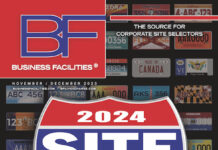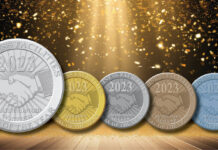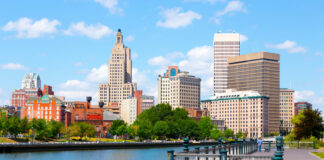Business Facilities Featured News
- All
- Podcasts & Webinars
- Economic Development
- Magazine
- Awards & Rankings
- Surveys, Research & Forecast Analysis
- Advanced Manufacturing
- Aerospace & Defense
- Automotive
- Biotech & Pharma
- Data Centers
- Food Processing
- Logistics & Distribution
- Manufacturing
- Office, IT & Call Centers
- Oil & Gas
- Plastics & Medical Devices
- Ports & Free Trade Zones
- Renewable Energy
- Retail
More
OTR, Birmingham Fastener Expand In Mexico
OTR Engineered Solutions will open its new facility in the Monterrey metropolitan area in August; Birmingham Fastener opened a new facility in Querétaro City last month.
Connecticut Sees Growth In Workforce, Emerging Industries
A growing population and a digital direction for the financial and insurance industries could set Connecticut up for success.
March / April 2024 Issue: A New Season For Location Decisions
Business Facilities' March / April 2024 issue focuses on manufacturing, including site selection for advanced manufacturing and digital adaption. Plus, food processing, life sciences, and much more.
January / February 2024: The Awards Issue
Business Facilities' January / February 2024 issue features Texas, our 2023 State of the Year, along with winners of our Deal of the Year Awards. Plus, 2024 Top Utilities and more.
November / December 2023 Issue (Volume 56, Number 6)
Business Facilities' November / December 2023 issue — the 2024 Site Seekers’ Guide — provides comprehensive information and resources for your relocation and expansion project decisions.
York County, South Carolina: Growing With Charlotte And Beyond
At the heart of the Carolinas’ largest metro, York County offers a diverse, thriving economy, great living choices, and room to grow.
[VIDEO] Get More for Your Business in Ardmore. Oklahoma
The ADA owns three industrial parks and several single sites and buildings, giving our organization both the power and incentive to negotiate favorable terms for expanding companies.
PLANT AGRICULTURAL SYSTEMS Locates In West Texas
With a vision to modernize the digital infrastructure required to support produce demand worldwide, PLANT AGRICULTURAL SYSTEMS chose the heartland of American agriculture to do just that.
Listen Now: Living And Learning In Lubbock, Texas, With John Osborne, CEO, Lubbock EDA
Lubbock EDA CEO John Osborne discusses business climate and downtown revitalization in the Business Facilities Podcast.
Listen Now: Talking Texas With Aaron Demerson, TxEDC President & CEO
Aaron Demerson, President & CEO of Texas Economic Development Corporation (TxEDC), shares his vision to continue to grow the state's success.
Listen Now: At LiveXchange With Jeff Troan On Data Analytics And Site Selection
Aerospace site selection and the value of data analytics is the focus of this recent talk with Jeff Troan, Managing Director at Vista Site Selection.
2023 Deals Of The Year
Entries for Deal of the Year awards spanned industries, investment types, and winning strategies. Here are the stories of this year’s picks.
2023 State Of The Year: Opportunity Awaits In Texas
A robust business climate and strategic growth during 2023 earns the Lone Star State this recognition.
Toyota, Tesla, Scout Motors, Amazon Web Services Top 2023 Deals Of The Year
EV industry, data center investments took top honors in Business Facilities’ annual awards, which recognize significant corporate relocation and expansion investments.
Connecticut Sees Growth In Workforce, Emerging Industries
A growing population and a digital direction for the financial and insurance industries could set Connecticut up for success.
Business Facilities Popular Posts
2023 Deals Of The Year
Entries for Deal of the Year awards spanned industries, investment types, and winning strategies. Here are the stories of this year’s picks.
2023 State Of The Year: Opportunity Awaits In Texas
A robust business climate and strategic growth during 2023 earns the Lone Star State this recognition.
Toyota, Tesla, Scout Motors, Amazon Web Services Top 2023 Deals Of The Year
EV industry, data center investments took top honors in Business Facilities’ annual awards, which recognize significant corporate relocation and expansion investments.
Texas Named Business Facilities’ 2023 State Of The Year
The strength and diversity of its business climate lands the Lone Star State the top spot for this annual economic development recognition from Business Facilities magazine.
OTR, Birmingham Fastener Expand In Mexico
OTR Engineered Solutions will open its new facility in the Monterrey metropolitan area in August; Birmingham Fastener opened a new facility in Querétaro City last month.
[VIDEO] Get More for Your Business in Ardmore. Oklahoma
The ADA owns three industrial parks and several single sites and buildings, giving our organization both the power and incentive to negotiate favorable terms for expanding companies.

The Business Facilities Online Site Seekers' Guide is the most comprehensive online directory of economic development agencies from around the world.
~ View the digital edition.
~ Print and online advertising.
Location Spotlight: The Rhode Island Advantage
Rhode Island’s ideal location in the Northeast boasts all the benefits of major commercial centers, including easy access to top companies, all manner of transportation, and world-class universities.
Business Facilities Surveys, Research & Forecast Analysis
Survey: Life Sciences Incubators Anticipate Continued Growth
In this first CBRE survey of its kind, incubators across the U.S. were asked about expectations related to funding and overall growth.
Site Selection In 2024: What Risks Define Business Investment Decisions?
Ongoing scarcities and geopolitical forces are among the factors that are impacting facility location decisions, according to a new study from the Site Selectors Guild.
Innovation And Talent: Top Performing Cities
Continued movement to more affordable, lifestyle-centric cities is further diversifying the landscape for innovation-focused companies and investors, according to JLL.
BF Editors’ Blog: On Location, Best Picture Nominees
The film and television industry has significant economic impact. With the upcoming 94th Academy Awards, here's a look at the filming locations for the Best Picture nominees.
New York, Illinois, Massachusetts Lead 2023 Top 10 States For Green Building
For the first time ever, New York has earned the top spot on the U.S. Green Building Council (USGBC) annual list of Top 10 States for LEED.
BF Editors’ Blog: How Do You Leverage AI In Site Selection?
Breaking down the pros and cons of AI in site selection and economic development industries, according to an IEDC report .



















![[VIDEO] Get More for Your Business in Ardmore. Oklahoma](https://businessfacilities.com/wp-content/uploads/2024/02/maxresdefault-218x150.jpg)










![[VIDEO] Get More for Your Business in Ardmore. Oklahoma](https://businessfacilities.com/wp-content/uploads/2024/02/maxresdefault-324x160.jpg)






